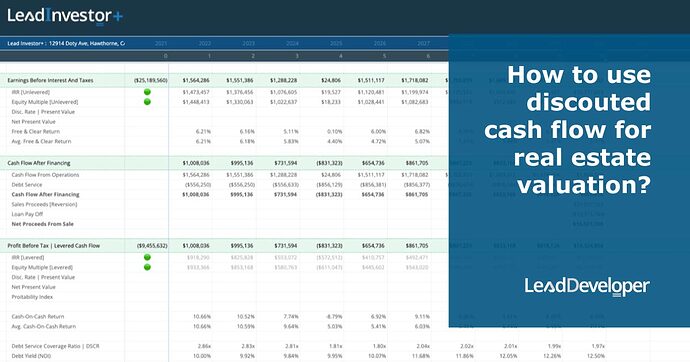Continued from…
How To Use Discounted Cash Flow For Real Estate Valuation [Part 1-2]
Why use a discounted cash flow method?
Three criteria make the discounted cash flows model the best choice for real estate valuations:
- As a result of opportunity cost, DCF recognizes and values the three main aspects of net investment: cash flow, time, and risk.
- The DCF model already dominates real estate investment valuation. Many of you undoubtedly already know it.
- The Discounted cash flow method is relatively efficient and extensively usable in modern spreadsheet applications. Calculations take seconds or less. In uncertain settings, the model can realistically reflect a wide range of complex situations, useful for valuing flexibility.
DCF focuses on cash vs accounting indicators like net income. Of course, accounting measures are vital and Discounted cash flow models frequently include and use them.
Cash is what you can employ in investments, business, and life. Accounting metrics are indirect representations, reflections, or actual or anticipated cash flow forecasts.
The “D” in DCF stands for time and risk. Inflation reduces the value of future cash flows.
- You may use the money in the meantime (for consumption or investment) and
- The future cash flows may not materialize in full or at all (no one has a crystal ball).
The discount rate used in the discount cash flows technique to convert future projected cash flows to Present Value accounts for both factors. It uses a discount rate that reflects what an investor could anticipate earning by investing in a similarly risky investment. It is simple, sleek, and intuitive.
The DCF model is not just sound economical, but it is widely used. DCF models use spreadsheets to organise data for value analysis.
Spreadsheets are ubiquitous in finance. Globally, business analysts and decision-makers use spreadsheets like Microsoft Excel. Spreadsheet software is a specific language in business and finance. It can help with communication, understanding, and utilisation.
Finally, DCF models based on computer spreadsheets have considerable analytical range and flexibility, especially in our effort to explicitly include uncertainty and flexibility in valuation.
Spreadsheets allow us to easily update one or more entries and recalculate to see the results instantly. Spreadsheets have two unique features for representing uncertainty and flexibility. These features are simple to set up and utilize.
First, we may utilize spreadsheets to calculate thousands of permutations of the same problem quickly. This feature allows us to cope with a wide range of economic and other variables that may affect an investment’s performance and thus its value.
This eliminates the need to limit our analysis to a few conceivable futures. To properly value flexibility, we need to look at probability distributions of possibilities in-depth, such as the effects of economic cycles and market movements.
Excel’s “data table” and “random number generator” functions provide this feature.
Assemble the spreadsheet to show a decision-maker taking suitable choices under the criteria we provide. We can develop an analogue investment and decision-making model. So we may automate decisions to sell a property in good times or defer construction in bad times.
This skill allows us to express and quantify the benefits of various options and decision flexibility. This method also allows us to simultaneously value several options, which many academic models of option valuation cannot. In Excel calculations, we use “IF statements”.
You are missing out if you haven’t yet subscribed to our YouTube channel.
Mistakes to avoid during DCF analysis
Real estate investors should avoid these three DCF Analysis mistakes:
- Investors often use the wrong Discount Rate when valuing a property. The Discount Rate should be based on the required rate of return for a similar investment.
- Investors often use optimistic assumptions when estimating future cash flows. It is important to be realistic when estimating future cash flows.
- Investors often forget to include all of the costs associated with a real estate investment when estimating future cash flows. Make sure to include all acquisition costs, holding costs, and selling costs when estimating future cash flows.
Learn More
Industry Insiders’ Secrets To Managing Risks & Avoiding Mistakes & Pitfalls In Property Development
Get the Risks & Mistakes Bundle Now
Includes 5 x detailed eBooks [120 pages]
✓ Risks In Property Development - Industry Insiders Guide (26 Pages)
✓ 10 Big (Financial) Property Investing Mistakes Made By Investors (58 Pages)
✓ 7 Property Development Mistakes And How To Avoid Them (8 Pages)
✓ 5 Reasons Buy-and-hold Investors Fail At Property Development (12 Pages)
✓ Property Mastermind: 8 Skills Needed For Property Development Success (16 Pages)
Conclusion
In conclusion, discounted cash flow is a powerful financial tool that you can use to make sound investment decisions.
By understanding the components of DCF analysis and using a realistic discount rate, you can make sound projections about a company’s future value or investment.
However, it is important to avoid common mistakes when performing a DCF analysis to get the most accurate results.
FAQs
Why use discounted cash flow in real estate?
Discounted cash flow (DCF) is the dominant valuation method for real estate investments for a few reasons:
- It’s easily translatable to modern spreadsheet applications.
- It reflects the time value of money by discounting future cash flows back to the present.
- It considers the risks associated with an investment, which is especially important when valuing illiquid assets like real estate.
Are NPV and DCF the same?
No, NPV and DCF are not the same. Discounted Cash Flow (DCF) is a method of valuing a project, company, or asset using the time value of money. Net Present Value (NPV) is the present value of all cash flows associated with an investment.
NPV includes positive and negative cash flows, while DCF only includes positive cash flows.






